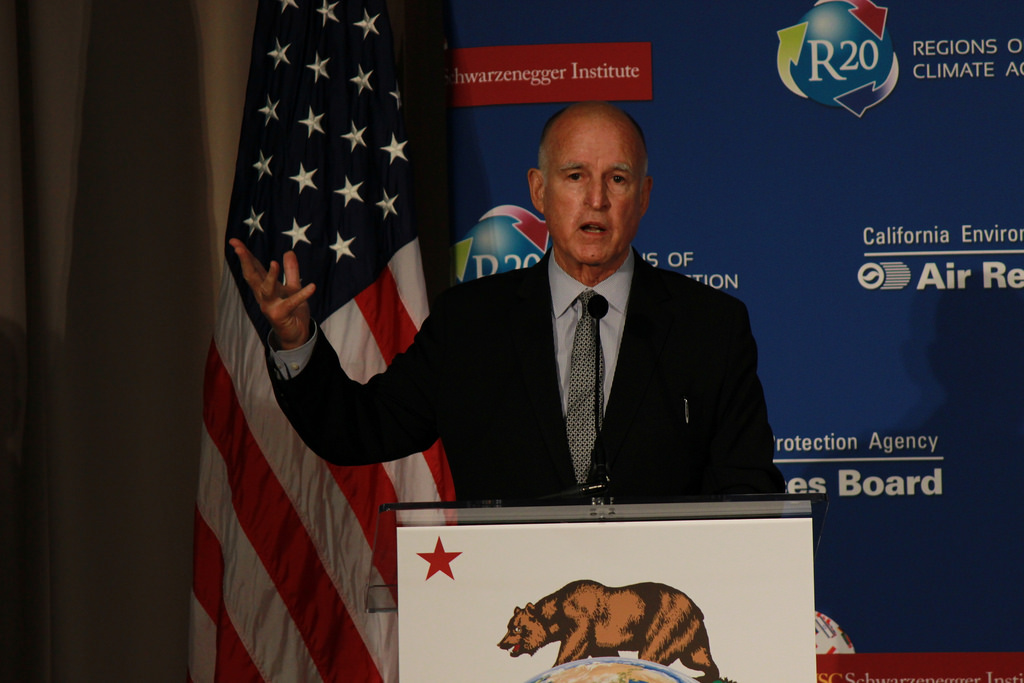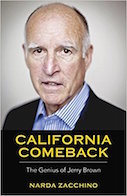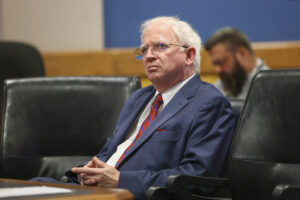How Jerry Brown Turned California Into a Model for America
"California Comeback" is an examination of the struggle between the regressive vision of Donald Trump and the progressive vision of Gov. Brown. California Gov. Jerry Brown. (California Air Resources Board / CC BY 2.0)
California Gov. Jerry Brown. (California Air Resources Board / CC BY 2.0)
Editor’s note: Veteran journalist Narda Zacchino’s book, “California Comeback: The Genius of Jerry Brown,” published by Heyday Books, takes an in-depth look at the remarkable progressive revolution that has occurred in the Golden State. In the following excerpt from the preface, Zacchino details how Jerry Brown has made a global impact as California’s governor and provided a counterbalance to Donald Trump’s regressive vision for America.

Purchase in the Truthdig Bazaar
The genius of Jerry Brown is that he has fundamentally reinvented both himself and California, arguably the most significant state in the country. Through two separate four-year terms as governor, he has established a bold model for progressive governance that is an inspiration for a nation mired in despair and frustration.
It has been a remarkable journey for a nation-state that was exposed early on to the reactionary nostrums of cultural xenophobia and nativism. But Californians have come to soundly reject at the polls these politics of meanness, defying the national swing to the right because divisive politics ultimately failed in a state that has historically thrived through growth and inclusion.
It has also been quite a journey for Jerry Brown. During his first two terms as governor of California from 1975 to 1983, Brown developed a reputation that was as much about style as substance. He was young and inexperienced in governance and could be downright quirky. “Governor Moonbeam,” a moniker he still disdains, attached to his image like icky glue. Today—seasoned by years of ruminating on mistakes and unfinished business; helming the large city of Oakland as mayor; and serving as attorney general, the state’s top law enforcer—he is the respected leader of the most influential and important state in the country and one that is admired throughout the world.
With a $2.6 trillion GDP, California is the largest economy on the planet behind number five United Kingdom and ahead of France. California climbed up from number ten just five years ago after Brown pulled the state back from the financial abyss with a 2012 voter-approved tax increase on the wealthy, saving California from bankruptcy and a dire future.
Brown has earned status on the world stage as a master player in combatting climate change, from which California has suffered tremendously due to punishing droughts, fires, and floods, with more predicted. This international role became more important when President Donald Trump withdrew from the Paris Climate Accords, foolishly leaving the United States as the only country in the world to not be part of the pact.
By November 2017, seeing his final term in office approaching the 2018 finish line, Brown donned his track shoes and began his sprint around the world to deliver the message that no president of the United States has the power to demolish sound environmental policy devised to combat human-caused global warming. He traveled to the Vatican and a United Nations conference in Bonn for major addresses on climate change action. In Bonn he accepted for the State of California a climate action award for outstanding policy. He also delivered opening remarks at a climate conference in Brussels organized by the European Union, and in Oslo he met with Norway’s prime minister and convened a meeting of the world’s leading scientists on climate change.
Acting more like the head of a nation than the governor of a state, Brown held a meeting in June 2017 with China’s President Xi Jinping, reported in the Los Angeles Times under the headline, “China is now looking to California—not Trump—to help lead the fight against climate change.” This was followed by a visit to the Eastern Economic Forum meeting in Vladivostok, Russia, where he spoke about the same topic to international government and business leaders.
In the United States, Brown is an effective counterweight to the dismantler-in-chief in the White House and the conservative Republican majority in Congress, whose strong desire is to undo much of what makes California the success it is. Under the leadership of Brown and the state’s Democratic legislature and attorney general, California stands in strong opposition to Trumpism and its attacks not just on climate change action but on Muslim immigrants; the rights of gay, lesbian, and transgender people; gun control; taxes; healthcare; and walling off the Mexican border.
The state continues to chart its own course, in some cases flaunting its independence by filing lawsuits against the administration for its policies that run counter to values supported by most Californians. The same day Trump established a new federal policy to allow employers to deny health insurance coverage for birth control, Attorney General Xavier Becerra filed a lawsuit alleging the president’s action was unconstitutional for violating anti-discrimination laws. Another suit was filed to stop Trump from building a wall at the Mexican border, and others challenged the Muslim travel ban, the plan to end the Deferred Action for Childhood Arrivals (DACA) program, changes to healthcare, and Trump’s action to roll back greenhouse gas and vehicle mileage standards.
Brown and the legislature earmarked $30 million in legal services and financial aid to undocumented students when Trump made his decision to cancel the DACA program. In October 2017, in the face of attacks by Trump and U.S. Attorney General Jeff Sessions, Brown signed into law a measure declaring California a sanctuary state, limiting what state law enforcement agencies can do to cooperate with the feds on deportation efforts. State officials had already told federal immigration officials to stay out of state buildings and courtrooms, where they seemed to be trolling for undocumented immigrants who might have been in court as witnesses, family members, or defendants.
Immigration bashing is a loser in a state where agriculture and other segments of the economy are dependent on immigrants, and where intermarriage of Latinos and Anglos brings happiness one day and fear the next, as Anglos worry about their new family members being deported.
While Trump and his education secretary Betsy DeVos favor school vouchers and charter schools, the right to a good public education is cherished by Californians, who voted themselves the 2012 tax increase when the main recipients were the state’s public schools. In October 2017, Brown signed a bill making the first year of community college tuition-free.
When transgender people serving in the U.S. military became the president’s target, California became the first state in the nation to enable people who do not classify themselves male or female to mark their driver’s licenses and change their birth certificates to “nonbinary,” to be designated by an “X” or “NB.”
The 2016 election demonstrated that people were yearning for change. Bernie Sanders represented a progressive populist response to what is not working, and Trump also expertly tapped into the pain of people, though he offered a reactionary, scapegoating view that is all too familiar now. The Democratic party establishment represented by Hillary Clinton failed to acknowledge the popular discontent in the nation, and it cost the election. The state’s party registration figures are an indication of the voting public’s mood, with 44.8 percent Democrats, 25.9 percent Republicans, and 24.5 percent “no preferred party,” or independent, up from 20.9 percent in 2013. The headline is that independents stand just 1.4 percent away from making the Republican party the third party of choice in California.
Brown has been able to fulfill his agenda by appealing to the better nature of Californians, drawing on the legacy of traditional progressive politics of his father, Governor Pat Brown (from 1959 to 1967), and his own earlier terms in the governor’s office. While much of the nation turned to the right in November 2016, California rejected that path, having long ago ended its flirtation with a sometimes mean-spirited conservatism for the simple reason that it did not work, examples being the anti-immigrant and anti-minority propositions in the 1990s, the energy deregulation crisis in 2000–2001, and tough-on-crime measures that in recent years were moderated by voters. All of these are dealt with in this book.
None of this is to suggest that California is free of issues that leave many of its residents feeling pain. While it is true that Brown governs the richest state in the union, it is also the poorest, with too many in the middle class for whom housing, healthcare, a college education for their children, and social mobility are increasingly unaffordable. California has the highest poverty rate in the nation at 20 percent, factoring in cost-of-living expenses, with another 20 percent “near poverty” according to the Public Policy Institute of California.
A contributing factor is increasing homelessness and unaffordable housing. In 2017, for example, while 425 people were living in tents in a since-demolished encampment in an old riverbed near the Anaheim Angels ballpark, the wait for affordable housing in Anaheim was about ten years. Los Angeles, with a shortage of half a million affordable housing units, counts about fifty thousand homeless people living in tents and cardboard shelters or on the pavement. In San Francisco the median price of a home was $1,380,000, while a house with less than two thousand square feet in the Silicon Valley city of Sunnyvale sold for $2.47 million, $782,000 over its listing price. The state’s overall median home price in August 2017 was $565,000, more than double the national average, and one-third of Californians say they spend most of their income on housing. This is not sustainable.
After months of sometimes tense negotiations with Democratic legislators, Brown signed into law fifteen housing bills to encourage development of more affordable housing and shelters for the homeless by cutting red tape, easing zoning laws, putting a $4 billion housing bond measure on the ballot, and other means to generate new housing for all Californians.
There are other serious issues. The state abides a justice system that unfairly puts too many black, brown, and poor white people in prison (some of them innocent) and a crowded prison system that provides little to no rehabilitative effort to prevent recidivism. Brown’s support of fracking leaves those who support his other environmental efforts scratching their heads and exercising their vocal chords in loud protest that mars his public appearances.
In November 2017, Brown took on public employee labor unions in an attempt to fix a looming pension deficit in the billions by arguing that such pensions could be lowered for current as well as future public employees.
With his term ending and no political race in his future, Brown can fight such battles that are unpopular with large numbers of steadfast Democratic voters.
The overall positive message of this book is that the country’s most vibrant and important state has firmly established itself as a model for the nation—certainly not for the white separatist crowd that adulates Trump, but for the general populace. Instead of tiptoeing around the issues of immigration, climate change, deregulation, and human rights, the state is now deep blue precisely because it has offered an uncompromising alternative that embraces immigration as an asset, establishes climate change action as a bedrock policy, pays more to strengthen public education, and protects the rights of all people. This book is an examination of the struggle between the regressive vision of Trump and the progressive vision of Jerry Brown, and how these battles were fought and won in California and exist to be emulated elsewhere.
To read another excerpt from “California Comeback,” click here.
Your support matters…Independent journalism is under threat and overshadowed by heavily funded mainstream media.
You can help level the playing field. Become a member.
Your tax-deductible contribution keeps us digging beneath the headlines to give you thought-provoking, investigative reporting and analysis that unearths what's really happening- without compromise.
Give today to support our courageous, independent journalists.






You need to be a supporter to comment.
There are currently no responses to this article.
Be the first to respond.